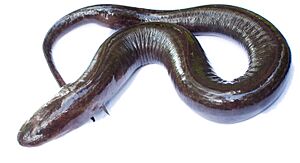Two-toed amphiuma facts for kids
Quick facts for kids Two-toed amphiuma |
|
|---|---|
 |
|
| Conservation status | |
| Scientific classification | |
| Genus: |
Amphiuma
|
| Species: |
means
|
The two-toed amphiuma (Amphiuma means) is a fascinating aquatic salamander. It lives mostly in the southeastern United States. People sometimes mistakenly call it a "congo snake" or "blind eel." But remember, it's actually a type of salamander!
Contents
What is a Two-Toed Amphiuma?
These unique creatures are the largest salamanders in the United States. They can grow to be over 3 feet (1 meter) long! They also weigh up to 2 pounds (1 kilogram).
Physical Features
Two-toed amphiumas have a long, snake-like body. They are usually black, dark gray, or dark brown. Their belly is a bit lighter than their back.
They have a pointed, wedge-shaped head. Their eyes are quite small. Even as adults, they keep a single gill slit on each side of their head. This helps them breathe underwater.
Tiny Legs and Two Toes
One of the most interesting things about them is their four tiny legs. These legs are called "vestigial," which means they are very small and not used much. Each leg has only two toes! This is how you can tell them apart from their relatives. Other amphiuma species might have one or three toes.
Where Do Two-Toed Amphiumas Live?
These salamanders love shallow water that has lots of plants. You can find them in places like swamps, bayous, lakes, and ponds. They also live in wet grassy areas called wet prairies.
They need soft soil where they can dig and hide. Their home range includes states like southeastern Virginia, Florida, and parts of Texas.
How Do Two-Toed Amphiumas Behave?
Two-toed amphiumas are active at night. This means they are nocturnal. They can be tricky to hold because their skin is very slippery!
Hiding and Hunting
They often dig burrows in muddy river bottoms. They might even use burrows made by other water creatures. They prefer areas where there are lots of fish and crayfish to eat. These areas often have floating plants or logs.
Sounds and Safety
If you leave them alone, they are harmless to humans. But if they feel threatened, they can give a strong bite! When disturbed, they sometimes make a clear whistling sound. Scientists have also learned that they make "clicking" sounds. They use these clicks to talk to each other over short distances.
Reproduction and Life Cycle
Two-toed amphiumas usually breed in the summer months. This happens from June to July in places like North Carolina and northern Florida.
Eggs and Hatchlings
The female amphiuma lays about 200 eggs. She places them in a damp, hidden spot near water. She then coils her body around the eggs. She stays there for about five months while the eggs develop. The eggs are laid in long strings.
When they hatch, the baby amphiumas are about 2 inches (5 centimeters) long. They are born with three pairs of light-colored external gills. These gills help them breathe. But they lose them soon after hatching. Sometimes, they can even hatch without external gills at all!
Scientists have found that the eggs can survive for a long time without food. They use energy stored in their yolk. They can also survive for many days on just a moist surface.
What Do Two-Toed Amphiumas Eat?
Two-toed amphiumas are carnivores, meaning they eat other animals. They are not picky eaters!
They hunt small fish, tadpoles, and crawfish. They also eat different kinds of insects and their larvae. Sometimes, they even prey on small reptiles and amphibians. This can include frogs, newts, water snakes, and small mud turtles.
Hunting Methods
They have two main ways of catching food. For small prey, they quickly open their mouth to suck in the food. For bigger prey, they strike fast with their sharp teeth. Then, they twist their body quickly to overpower the prey.
Scientists believe they actively search for food. They also might wait hidden in burrows or under debris for prey to come close. They likely use their sense of smell to find their next meal.
Images for kids




